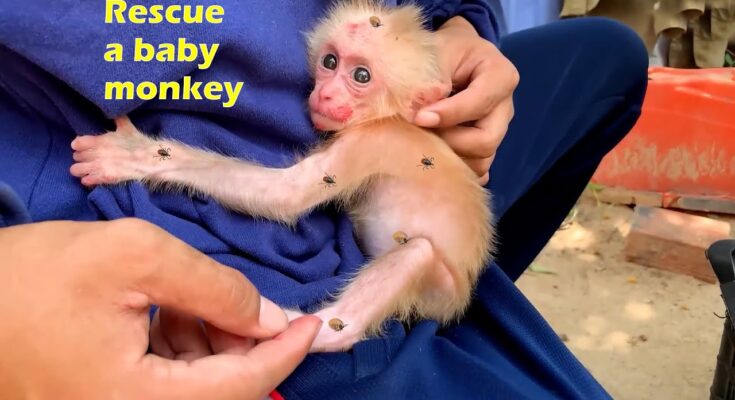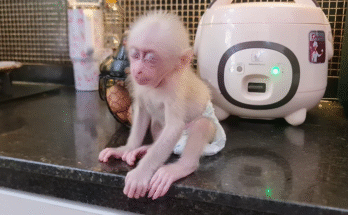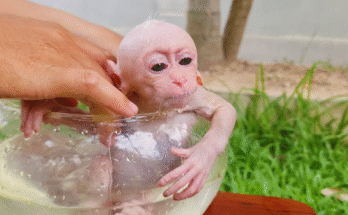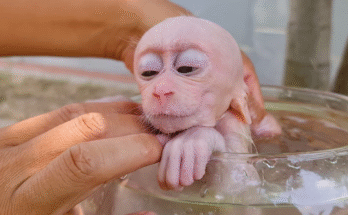How to Care for an Abandoned Baby Monkey Found in the Wild
Caring for an abandoned baby monkey requires patience, knowledge, and dedication. First, ensure the monkey is warm, as young primates are highly vulnerable to cold. Provide a soft blanket and a heat source if needed. Hydration is crucial, so offer electrolyte solutions before introducing a specialized milk formula. Feed small amounts frequently to avoid digestion issues. Keep the monkey in a quiet, safe environment to reduce stress. If injured or weak, seek veterinary assistance immediately. Socialization is key—spend time bonding while maintaining hygiene. Finally, consult wildlife experts to determine if rehabilitation or sanctuary care is the best option.
1. The First Steps: From Clinging to Crawling
At birth, a newborn monkey lacks the strength to walk independently. Instead, it clings tightly to its mother’s fur, feeling comforted by her heartbeat and warmth. In the first few days, the baby begins experimenting with small movements, attempting to shift its position while still holding on. Soft cooing sounds from the mother encourage the baby to stay close, while her movements provide a natural rhythm, teaching the infant how to balance and adjust. This stage is crucial for muscle development, laying the foundation for future mobility.
2. Recognizing Sounds and Environmental Cues
As the baby monkey grows, it becomes more aware of the sounds surrounding it. The gentle rustling of leaves, the distant calls of its troop, and its mother’s reassuring vocalizations help shape its sense of space and direction. These sounds act as an auditory guide, signaling when to move, pause, or seek safety. By listening and responding to these cues, the newborn learns to associate movement with security, gradually building the confidence to step away from its mother for short moments.
3. Strengthening Muscles: Small Steps with Big Progress
By the second or third week, the baby monkey begins testing its strength by attempting short, shaky steps while still supported by its mother. The soft padding of the forest floor absorbs its tiny missteps, allowing it to explore safely. At this stage, it starts using its hands and feet more effectively, gripping tree roots or nearby objects for balance. The rhythmic sounds of footsteps from other monkeys in the troop further encourage movement, signaling that walking is a natural and essential part of survival.
4. Learning Through Play and Interaction
Playtime is a crucial element in the development of walking skills. As the baby monkey interacts with siblings and other young members of the troop, it mimics their movements, learning through observation and practice. Small jumps, playful chases, and gentle tumbles refine coordination. The sounds of laughter-like vocalizations from other juveniles act as encouragement, reinforcing positive movement. With each playful step, the baby gains more confidence, transitioning from hesitant movements to purposeful strides.
5. Achieving Independence: Walking with Confidence
By the end of the first month, the baby monkey can take independent steps, though it still remains close to its mother. The once-fragile newborn now moves more steadily, using the sounds of nature—chirping birds, rustling leaves, and the rhythmic footsteps of the troop—as a guide. This stage marks a significant milestone in its journey toward independence. While it may still stumble occasionally, the baby monkey’s ability to walk confidently signals a new chapter in its development, preparing it for the challenges and adventures ahead.
Best Practices for Raising a Baby Monkey
Raising a baby monkey requires patience, care, and proper nutrition. Provide a warm and safe environment to ensure comfort. Feed them a balanced diet, including fruits, vegetables, and essential nutrients to support growth. Regular veterinary checkups are crucial for their health. Socialization is key—interact with them daily to build trust and prevent loneliness. Hygiene is essential; keep their living space clean and groom them regularly. Avoid human-like behaviors to maintain their natural instincts. Training with positive reinforcement helps develop good habits. By following these best practices, you ensure a healthy, happy monkey while promoting responsible care.
Best Practices for Raising a Baby Monkey
Raising a baby monkey is a challenging yet rewarding responsibility that requires dedication, knowledge, and proper care. Unlike domestic pets, monkeys have unique needs that must be met to ensure their physical and emotional well-being. Here are three essential best practices for raising a baby monkey the right way.
1. Providing a Proper Diet and Nutrition
A baby monkey’s diet plays a crucial role in its overall health and development. Since monkeys have complex nutritional requirements, feeding them the right food is essential. A balanced diet should include:
- Fresh Fruits & Vegetables: Bananas, apples, grapes, carrots, and leafy greens provide essential vitamins and minerals.
- High-Quality Protein Sources: Boiled eggs, cooked chicken, and specialized monkey biscuits support muscle growth.
- Milk or Formula for Infants: If the baby monkey is too young, a veterinarian-approved milk formula is necessary for proper nourishment.
- Hydration: Clean water should always be available to prevent dehydration.
Avoid giving processed foods, sugary treats, or toxic foods like chocolate and onions, as they can harm the monkey’s digestive system. A well-balanced diet ensures a healthy, strong, and active baby monkey.
2. Creating a Safe and Comfortable Environment
Monkeys are highly intelligent and energetic animals that require a secure and stimulating environment. A well-designed living space should include:
- A Spacious Cage or Enclosure: The enclosure must be large enough for climbing, jumping, and playing. A well-secured space prevents escapes and injuries.
- Natural Elements: Adding branches, ropes, and climbing structures mimics a monkey’s natural habitat, keeping them engaged and mentally stimulated.
- Warmth & Comfort: Baby monkeys need warmth, especially in the early weeks. Soft blankets, heating pads, or warm water bottles help maintain their body temperature.
- Clean and Hygienic Space: Regularly clean the enclosure to prevent bacteria buildup, ensuring a healthy living environment.
A safe and enriching environment allows baby monkeys to thrive physically and emotionally while reducing stress and anxiety.
3. Socialization and Proper Training
Monkeys are social animals that require constant interaction to develop good behavior and strong emotional bonds. The best ways to socialize and train them include:
- Daily Interaction: Spend quality time with the monkey to build trust and prevent loneliness. Lack of socialization can lead to behavioral issues.
- Positive Reinforcement Training: Reward good behavior with treats and praise while discouraging unwanted actions in a gentle manner.
- Exposure to Other Monkeys: If possible, introduce the baby monkey to others to develop natural social skills and prevent isolation.
- Preventing Aggressive Behavior: Monkeys can develop aggressive tendencies if not trained properly. Setting boundaries early helps prevent biting, scratching, or destructive behavior.



